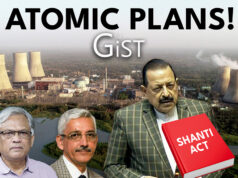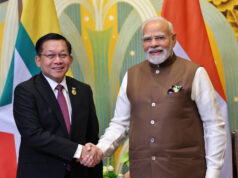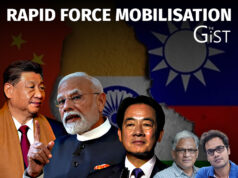NEW DELHI: That information landscape is now the fifth domain of war-fighting is an accepted fact. However, the difference between the other four domains and the information space (in a limited sense, the public information space) is that the latter needs constant engagement and careful dissemination.
As someone who conducts workshop and speaks on information and influence operations at different places, I found a new case study today: The Prime Minister’s speech at the all-party meeting on Friday and the message that it conveyed initially.
As we now know, on Friday, Mr Modi made his concluding remarks at the all-party meeting. As soon as his small byte was flashed across TV news and social media platforms, all hell broke loose with the twitterati and commentators pillorying him—rightfully so—for giving an impression that he had capitulated to the Chinese.
On Saturday, a clarification was issued from the Prime Minister’s Office (PMO), shedding some more light on the issue. Going through the original statement issued on June 19 and the clarification issued on 20 June, this is what one could discern:
June 19 statement:“Prime Minister underscored that today all of us stand united with the soldiers defending our borders and repose full faith in their courage and bravery. He added that through the All Party Meeting, he wants to assure the families of the martyrs that the entire country stands with them.
At the outset, Prime Minister clarified that neither is anyone inside our territory nor is any of our post captured. He said that twenty of our brave soldiers made the supreme sacrifice for the nation in Ladakh but also taught a lesson to those who had dared to look towards our motherland. The nation will forever remember their valour and sacrifice.”
The clarification on June 20 said this: “Attempts are being made in some quarters to give a mischievous interpretation to remarks by the Prime Minister at the All-Party Meeting (APM) yesterday.
Prime Minister was clear that India would respond firmly to any attempts to transgress the Line of Actual Control (LAC). In fact, he specifically emphasized that in contrast to the past neglect of such challenges, Indian forces now decisively counter any violations of LAC (“unhe rokte hain, unhe tokte hain”).
The APM was also informed that this time, Chinese forces have come in much larger strength to the LAC and that the Indian response is commensurate. As regards transgression of LAC, it was clearly stated that the violence in Galwan on 15 June arose because Chinese side was seeking to erect structures just across the LAC and refused to desist from such actions.
The focus of the PM’s remarks in the APM discussions was the events of 15 June at Galwan that led to the loss of lives of 20 Indian military personnel. Prime Minister paid glowing tributes to the valour and patriotism of our armed forces who repulsed the designs of the Chinese there. The Prime Minister’s observations that there was no Chinese presence on our side of the LAC pertained to the situation as a consequence of the bravery of our armed forces. The sacrifices of the soldiers of the 16 Bihar Regiment foiled the attempt of the Chinese side to erect structures and also cleared the attempted transgression at this point of the LAC on that day.”
In my assessment, this is what likely happened, resulting in messed-up messaging: Since TV channels would have been clamouring for bytes from the PM’s concluding remarks at the meeting for their prime time shows, under deadline pressure only the opening sentences were shared as audio-visual bytes. As often happens, the byte was immediately flashed on every TV channel and on social media. Without the full context, the statement appeared to be misleading, making people conclude that India was accepting the fait accompli that China was forcing at the border.
Now, in hindsight, there is much needed clarity. Let us analyse what the Prime Minister actually said.
The PM made eight key points in his closing address:
- There has been no intrusion leading to capture of posts.
- The 20 gallant soldiers who made the supreme sacrifice made the enemy pay a heavy price and taught a lesson forever. Their sacrifice will not be forgotten.
- Our forces are fully geared up in all dimensions and will maintain required deterrence.
- We have given full autonomy to the forces to take appropriate action at the operational level.
- We desire peace and diplomatic efforts are on simultaneously to resolve the issue in a peaceful manner.
- Our sovereignty is of utmost importance to us and we have made dedicated efforts to upgrade and improve border infrastructure in the past five years.
- Better infrastructure has resulted in higher patrolling and checking of Chinese movements by our forces.
- India has never succumbed to external pressure on any issue and the same will be the case on this one too.
Given the pressure of time and compulsions of deadlines, the media and social media cherry-picked the first two sentences and only the first point, leading to a barrage of outrage.
The statement viewed in its entirety and objectively actually conveys the spirit of consensus-building which the Prime Minister and the government attempted at the all-party meet.
Prime Minister Narendra Modi and his team, otherwise masterful communicators, may have stumbled a bit on Friday but if one looks at the seven of the eight points made in his statement, the PMO recovered quickly much like a cricket team going on to win a match after losing an early wicket.
“What is Indian territory is clear from the map of India. This Government is strongly and resolutely committed to that,” the statement from PMO said in the wake of some confusion over Modi’s remarks on Friday at an all party meeting on Friday.
The lesson here for everyone involved is to perhaps be extremely careful in setting the context of the statement and make sure there is adequate time for the people who carry it forward to read, digest and then disseminate.
Nitin A. Gokhale is a media entrepreneur, one of South Asia's leading strategic affairs analyst and author of over a dozen books so far on military history, insurgencies and wars.
Starting his career in journalism in 1983, he has since led teams of journalists across media platforms.
A specialist in conflict coverage, Gokhale has covered the insurgencies in India’s North-East, the 1999 Kargil conflict and Sri Lanka’s Eelam War IV between 2006-2009.
Gokhale now travels across the globe to speak at seminars and conferences, and lecture at India’s premier defence colleges. He has founded three niche portals, Bharatshakti.in, stratnewsglobal.com and Interstellar.news.




